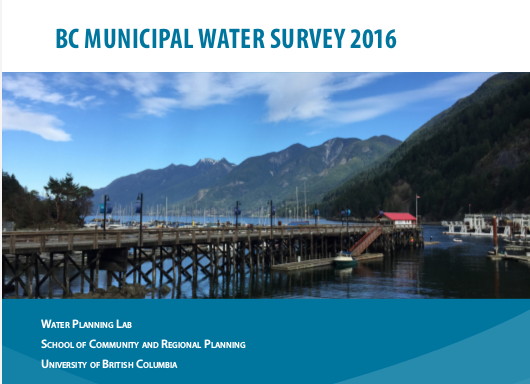The BC Municipal Water Survey 2016 presents an overview of local water use, pricing, and metering coverage in the province of British Columbia. In the summer and autumn of 2015, we contacted local governments to ask them basic questions about water use in their jurisdiction. Our survey was designed to provide continuity with Environment Canada’s Municipal Water and Wastewater Survey. We obtained responses from 45 local governments, which correspond to 66% of the population in the province and 32% of the local governments. The response rate is comparable to the last Municipal Water and Wastewater Survey released by Environment Canada in 2011 with data from 2009.
We find that water use in liters per capita per day (lpcd) continues to fall, with total water use dropping 18% to 494 lpcd, and residential water use falling 12% to 312 lpcd from 2009. If our survey results accurately estimate water use trends, the province would be on track to meet its target to improve water efficiency by 33% by 2020.
We find a metering coverage rate of 26% percent of water connections in the province. Among single family connections, the metering rate is 36%, while 18% of multifamily homes are individually metered. Notably, our metering coverage rate for single family connections is lower than the 40% that can be estimated with the data from Environment Canada (2011). Despite the low metering coverage rates reported, we find that an important number of municipalities are transitioning to universal metering, or have semi-mandatory metering programs that are gradually bringing water meters into communities throughout the province. We expect metering coverage rates to rise.
On average, local governments in BC charge residents $394 a year for water services. Two thirds of the municipal governments in our survey still use a flat fee rate structure. The average flat fee in the province for a typical residential connection is $381. Only one third of municipal governments charge fees based on volumes of water consumed. Of these, most use a constant unit charge, rather than an increasing block rate. Assuming that an average resident consumes 25 m 3 per month, residents with volumetric rate structures pay on average $418 per year. Finally, we observe that the rate charged by municipalities is highly variable throughout the province, ranging between $135 to $782.
Lastly, we inquired about water conservation programs implemented by local governments. The most common water conservation measures are educational campaigns (80%), mandatory restrictions (73%), and an active leak-detection program (58%). On the other extreme, only one municipality reported having a residential water reuse program; two reported having seasonal water pricing; and two had municipally-implemented ICI water reuse programs.
Our results present the most up to date analysis of local water use in British Columbia. Nevertheless, there remain major gaps. Therefore we call for improved collaboration among municipal planners, researchers and government officials in order to compile a comprehensive data set on municipal water use, pricing and metering coverage in the province of British Columbia.
Read the complete report below (or download it from this source):
